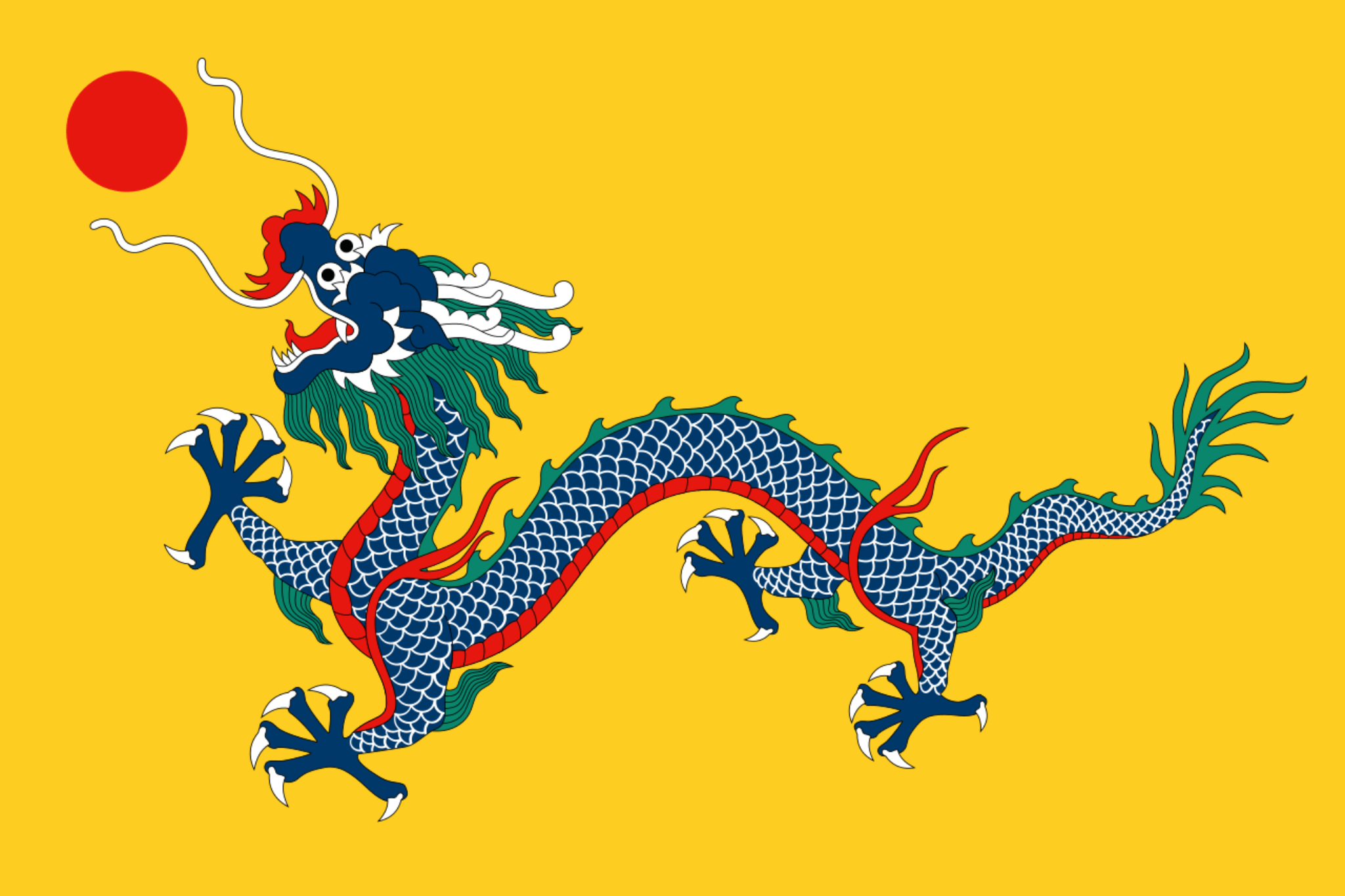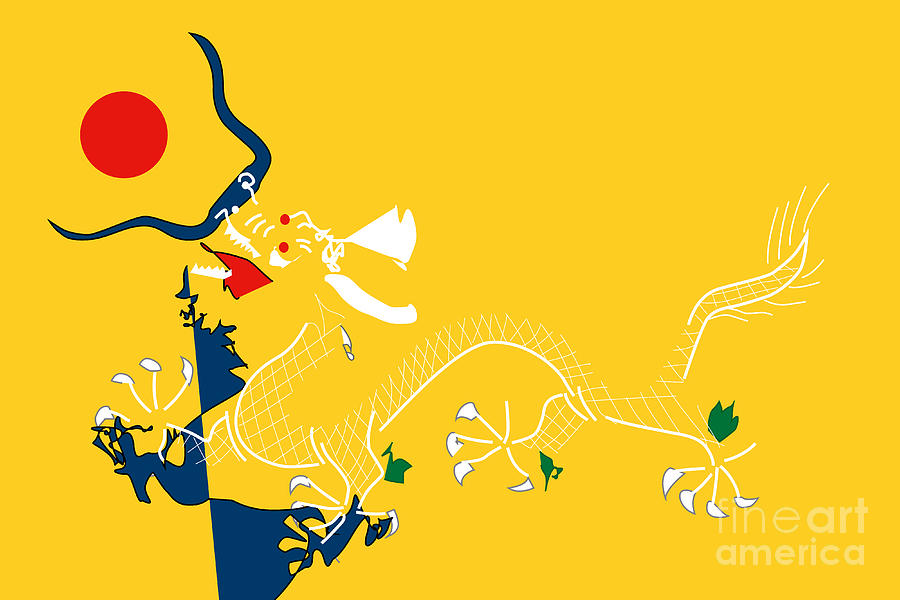
Image Imperial China Flag AvA.png Alternative History FANDOM
IMPERIAL CHINA: Flag of Imperial China Qin Dynasty (Chinese: 秦朝; pinyin: Qín cháo) also known as the Ch'in dynasty, established the first great Chinese empire. The Ch'in (Qin), from which the name China is derived, established the approximate boundaries and the basic administrative system that all subsequent Chinese dynasties were to.

Flag of China What Does It Mean? Symbol Sage
During this period, only the members of China's imperial family were allowed to wear the color yellow. Similarly, the five-clawed blue dragon in its center represented imperial power and strength. In fact, only emperors were allowed to use this emblem.
Chinese Dragon Flag Large 5 x 3 FT Imperial Dynasty China New Year
The flag of the Republic of China, commonly called the flag of Taiwan, consists of a red field with a blue canton bearing a white disk surrounded by twelve triangles; said symbols symbolize the sun and rays of light emanating from it, respectively.. The flag was originally designed by the anti-Qing group, Revive China Society, in 1895 with the addition of the red field component in 1906 by Sun.

Flags of the Union of Free Chinese Republics vexillology
The uprising against imperial rule, led by revolutionary forces, saw the emergence of the first national flag of China. This flag, known as the "Five-Colored Flag," featured horizontal stripes of red, yellow, blue, white, and black, representing the five major ethnic groups in China. The Nationalist Era

Emblem of the Great Chinese National Empire by FriedrichHabsburg on
The Qing dynasty ( / tʃɪŋ / ching ), officially the Great Qing, [c] [d] was a Manchu -led imperial dynasty of China and the last imperial dynasty in Chinese history. [e] It emerged from the Later Jin dynasty founded by a Tungusic-speaking ethnic group who became known as the Manchus.

FileNew Chinese Imperial Flag.svg Alternative History FANDOM
From 1862 to 1912, the flag of China constituted five colors. This was red, yellow, blue, white, and black. The base of the flag was yellow with a blue dragon at the center and a red disk at the upper left corner. The back of the dragon consisted of white and black horizontal bands. The Qing dynasty's decline culminated in 1912.

Republic of China Flag Redesign r/vexillology
The flag debuted in Beijing's Tiananmen Square on October 1, 1949, the day that the People's Republic of China was formally announced. Chinese flag | © WikiCommons Zeng was surprised to see his design chosen, especially because of the omission of the hammer and sickle.

Redesign of the flag of the Qing Dynasty r/vexillology
Our line of Naval Quarterdeck products feature commonly used items such as ceremonial wood quarterdeck bullets,chrome missile stanchions,ceremonial bullet ropes, port and starboard running lights, ceremonial red carpet, ship and command crests,custom made wood bell and flag stands and ship rugs. Please email us with your custom order requests and we will provide a quote.

Imperial China Flag Digital Art by Frederick Holiday Fine Art America
Chinese Empire flag in 1705 Flagbook. image located by Vanja Poposki, 20 August 2012. Flag of Chinese Empire as it was presented in the book "Niewe Hollandse Scheeps Bouw" by Carel Allard, issued in 1705, and edited and re-issued in Sankt-Peterburg in Russian with comments in 1911.Vanja Poposki posted in I Love Flags, 20 August 2012. The source of this flag would appear to be Carel Allard.

PreQing Ancient China's imperial flag the Great Chang vexillology
Imperial China, an introduction. Imperial Chinese history is marked by the rise and fall of many dynasties and occasional periods of disunity, but overall the age was remarkably stable and marked by a sophisticated governing system that included the concept of a meritocracy. Each dynasty had its own distinct characteristics and in many eras.

China Chinese Imperial Dragon Flag 3' x 5' Standard Ultimate Flags
Pilot Flag (China) Chinese Imperial Nautical Flags. Qing Dynasty: Beiyang Fleet 1894-1895; Chinese Imperial Naval Rank Flags (1905) Imperial Chinese Navy Flags (1909) Black Flag Army ; Other 20th Century China flags; Pre-Republic Rank Flags (1912) [China] Early Twentieth Century Proclaimed States .

The Voice of Vexillology, Flags & Heraldry Mushu Imperial China Flag
During the final years of the Qing Dynasty, a set of officials' rank flags were adopted in China. These were the Imperial Dragon (National) Flag, with the officials' rank insignia (known as the Mandarin Square, originally worn on the officials' surcoats) arranged horizontally in the upper fly, above the back of the Imperial dragon.These flags would be flown, for example, above Chinese.

The flags of Republic of China (ROC) and Imperial Japan Combined r
Imperial China, an introduction. Imperial Chinese history is marked by the rise and fall of many dynasties and occasional periods of disunity, but overall the age was remarkably stable and marked by a sophisticated governing system that included the concept of a meritocracy. Each dynasty had its own distinct characteristics and in many eras.

Dinastia Qing 18621912 (Bandeira do Imperador) Flag, Chinese flag
July 4, 2018. As the world confronts President Donald Trump's "America First" protectionism, one product stands at the symbolic center of today's trade war: American flags made in China. A.

Two Centenaries Wikipedia
The Empire of China was a short-lived attempt by Chinese president Yuan Shikai from late 1915 to early 1916 to reinstate the monarchy in China, with himself as emperor. The attempt ultimately failed, set back the republican cause by several years, and led China into a period of fracture and conflict among various local warlords.

Flag of a unified China vexillology
The national flag of the People's Republic of China, also known as the Five-star Red Flag, [1] is a Chinese red field with five golden stars charged at the canton. The design features one large star, with four smaller stars in an arc set off towards the fly.